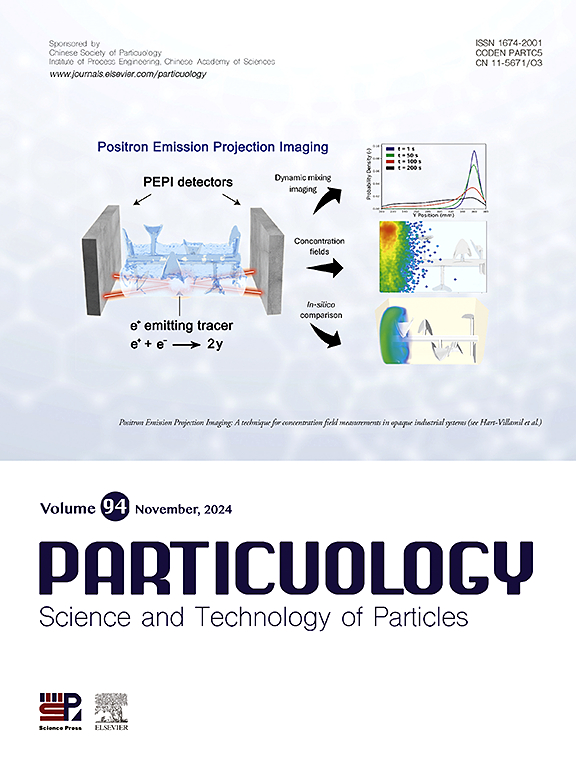Molecular structural characterization and model construction of residual carbon in coal gasification fine slag
IF 4.3
2区 材料科学
Q2 ENGINEERING, CHEMICAL
引用次数: 0
Abstract
The residual carbon contained in coal gasification fine slag (CGFS-RC) is a valuable resource with great potential for application, and the elucidation of the macromolecular structural model of CGFS-RC is an important basis for its recovery and utilization. In this paper, CGFS-RC was comprehensively characterized by proximate, ultimate, FTIR, XRD, XPS, and HRTEM analyses, and the macromolecular geometric model of CGFS-RC was constructed and optimized using Materials Studio software. The results show that carbon atoms in CGFS-RC mainly exist in the form of aromatic carbons with a high percentage of 90.7 %, and the ring number of condensed aromatic rings is mainly 3–5. The aliphatic carbon side chain structure on the benzene ring is mainly dominated by cycloalkanes. Among the heteroatoms, oxygen atoms are mainly present in the form of ether-oxygen bonds, (phenolic) hydroxyl groups, carbonyl groups and carboxyl groups, while nitrogen atoms are mainly present in the form of pyrroles. The molecular formula of CGFS-RC can be expressed as C165H41O13N, and the density of its geometrical configuration was calculated to be 1.65 g/cm3. The XRD and FTIR simulation confirmed the reasonableness of the constructed model, and the electrostatic potential simulation revealed the hydrophilic properties of CGFS-RC at the molecular level. This study opened up the molecular structure analysis and modeling process of CGFS-RC, which can provide fundamental basis for the reagent design in the flotation recovery of CGFS-RC as well as the resource utilization of CGFS-RC.

煤气化细渣残碳分子结构表征及模型构建
煤气化细渣(CGFS-RC)中残余碳是一种具有巨大应用潜力的宝贵资源,而CGFS-RC大分子结构模型的阐明是其回收利用的重要依据。本文通过近似值、极值、FTIR、XRD、XPS、HRTEM等分析手段对cfs - rc进行了综合表征,并利用Materials Studio软件构建并优化了cfs - rc的大分子几何模型。结果表明:CGFS-RC中的碳原子主要以芳香碳的形式存在,占90.7%,且缩合芳香环的环数主要为3 ~ 5个;苯环上的脂肪族碳侧链结构以环烷烃为主。杂原子中,氧原子主要以醚氧键、(酚)羟基、羰基和羧基的形式存在,氮原子主要以吡咯的形式存在。CGFS-RC分子式可表示为C165H41O13N,其几何构型密度计算为1.65 g/cm3。XRD和FTIR模拟证实了所构建模型的合理性,静电势模拟揭示了CGFS-RC在分子水平上的亲水性。本研究开辟了CGFS-RC的分子结构分析与建模过程,可为CGFS-RC浮选回收药剂设计及资源利用提供基础依据。
本文章由计算机程序翻译,如有差异,请以英文原文为准。
求助全文
约1分钟内获得全文
求助全文
来源期刊

Particuology
工程技术-材料科学:综合
CiteScore
6.70
自引率
2.90%
发文量
1730
审稿时长
32 days
期刊介绍:
The word ‘particuology’ was coined to parallel the discipline for the science and technology of particles.
Particuology is an interdisciplinary journal that publishes frontier research articles and critical reviews on the discovery, formulation and engineering of particulate materials, processes and systems. It especially welcomes contributions utilising advanced theoretical, modelling and measurement methods to enable the discovery and creation of new particulate materials, and the manufacturing of functional particulate-based products, such as sensors.
Papers are handled by Thematic Editors who oversee contributions from specific subject fields. These fields are classified into: Particle Synthesis and Modification; Particle Characterization and Measurement; Granular Systems and Bulk Solids Technology; Fluidization and Particle-Fluid Systems; Aerosols; and Applications of Particle Technology.
Key topics concerning the creation and processing of particulates include:
-Modelling and simulation of particle formation, collective behaviour of particles and systems for particle production over a broad spectrum of length scales
-Mining of experimental data for particle synthesis and surface properties to facilitate the creation of new materials and processes
-Particle design and preparation including controlled response and sensing functionalities in formation, delivery systems and biological systems, etc.
-Experimental and computational methods for visualization and analysis of particulate system.
These topics are broadly relevant to the production of materials, pharmaceuticals and food, and to the conversion of energy resources to fuels and protection of the environment.
 求助内容:
求助内容: 应助结果提醒方式:
应助结果提醒方式:


